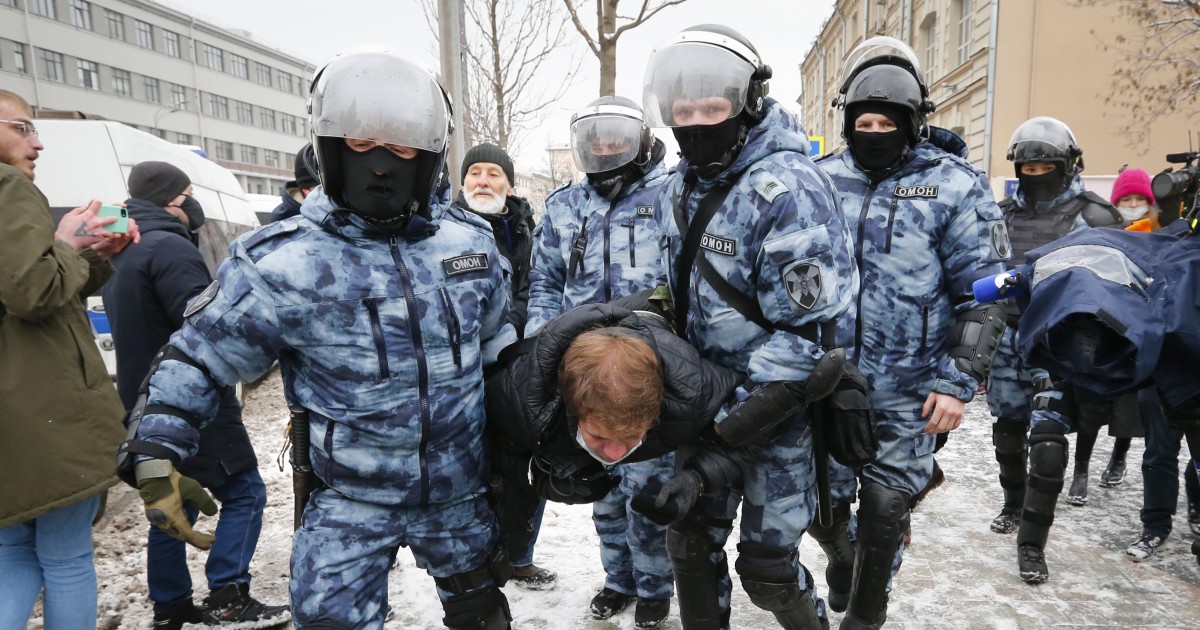Chants of “Putin is a thief!” and “Freedom!” echoed through snowy streets and squares of Russia on Sunday, as tens of thousands of protesters turned out across the country in a show of support for jailed anti-corruption activist Alexei Navalny.
More than 5,000 people were arrested nationwide, a monitoring group said, as the demonstrations triggered a massive and often heavy-handed police response. Those detained included Navalny’s wife, Yulia.
The protests in Moscow and elsewhere across the vast country marked a second straight weekend of demonstrations demanding freedom for Alexei Navalny, who was arrested Jan. 17 upon his return to Russia from Germany. The 44-year-old activist had spent five months in Berlin recuperating from an attempt to kill him with a military-grade nerve agent, which was widely blamed on Russia’s security apparatus.
The Kremlin has denied any role in the poisoning. Russian President Vladimir Putin has shrugged off allegations of massive graft in his inner circle, and has warned Western governments not to interfere in Russia’s internal affairs.
Some of the protesters who came out Sunday termed the moment a watershed. “I wanted to be part of it,” said Anton Molchanov, 60, in Moscow. He said Navalny’s poisoning in August marked “a serious turn in our history.”
Signaling a change in tone toward Russia by the new U.S. administration, Secretary of State Antony Blinken on Sunday condemned the “persistent use of harsh tactics” against peaceful protesters. In an early-morning tweet, Blinken called on Russia to release Navalny and others detained for “exercising their human rights.”
The Russian monitoring group OVD-Info, which tracks political arrests, said more than 4,900 were detained nationwide, surpassing a total of about 4,000 on Jan. 23. Organizers have called for more protests in coming days.
In Moscow, authorities sealed off a large swath of the capital’s center to pedestrians before the protests began, shutting down seven Metro stations and deploying riot police on nearly every corner. In another preemptive move, police snatched people off the street before the demonstrations began in earnest, dragging them to waiting police buses.
The initially designated protest spot in Moscow was highly symbolic: Lubyanka Square, where the headquarters of the security service that Navalny accuses of poisoning him is. As police blocked off access to it and other sensitive sites, protest organizers used messaging apps and social media to set new venues, spreading to many parts of the city.
Crowds marched toward Matrosskaya Tishina, a prison in northern Moscow where Navalny is being detained; police beat them back.

A policeman detains a man during a protest in St. Petersburg, Russia, on Sunday.
(Valentin Egorshin / Associated Press)
In far-flung parts of the country, bitter winter temperatures did not deter demonstrators who massed on a frozen bay in Vladivostok, in Russia’s Far East. In the old imperial capital of St. Petersburg, the country’s second-largest city, some protesters jeered Putin as a “czar.”
The demonstrations were galvanized not only by fears over Navalny’s fate, but by deep popular anger over official corruption, and discontent spurred by previous crackdowns.
A 28-year-old scientist, Pavel Shilkovsly, said he was not a Navalny supporter, but “I want something to change — I want democracy here.”
In the days leading up to the demonstrations, authorities warned of harsh punishments for those who took part. Russian officials who have often been notably lax on COVID-19 precautions cited anti-virus rules as a rationale for banning the gatherings. Navalny’s brother Oleg was placed under house arrest, and police raided several properties associated with his movement.
Navalny has already been handed a 30-day sentence for parole violations, and next week, a court will hear charges that could result in imprisonment up to three and a half years. Navalny and his followers say the allegations against him, including fraud, are politically motivated.
The movement led by Navalny has called for sanctions against dozens of individuals associated with Putin, threatening millions of dollars in what critics say are ill-gotten assets. The Kremlin has dismissed Navalny’s corruption claims, including the allegation that wealthy associates of Putin paid for a sprawling Black Sea palace that has been placed at the leader’s disposal.
Before the latest round of protests, a Putin ally, businessman Arkady Rotenberg, came forward to say the luxurious Black Sea compound belonged to him, but Navalny’s description of it as a huge bribe of Putin by cronies appeared to have struck a chord.
“It’s the video with Putin’s palace that made me want to come,” said 37-year-old Mariya Varand, who said she did not often attend protests. “I’m protesting against corruption, and the fact that they put innocent people in jail.”
Many in the crowds were young people, but some older demonstrators said they felt compelled to support the next generation by turning out as well.
“I have children and grandchildren, and I don’t want them to live in a police state,” said Irina Molchanova, who is 63. “I’m afraid to go out to protest, but I’m more worried about my children’s future.”
Kolotilov is a special correspondent. Staff writer Laura King in Washington contributed to this report.
This article is auto-generated by Algorithm Source: www.latimes.com


